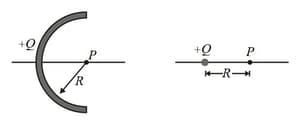Two charged beads are on the plastic ring in figure (a). Bead, which is not shown, is fixed in place on the ring and has a radius Bead which is not fixed in place is initially on the-axis at angle It is then, moved to the opposite side, at angle through the first and second quadrants of the coordinate system. Figure (b) gives the-component of the net electric field produced at the origin by the two beads as a function of , and figure (c) gives the-component of that net electric field. The vertical axis scales are set by and At what angle is bead located? What are the charges of bead and bead
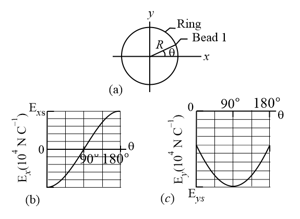


Important Questions on Electric Fields
Figure (a) shows a circular disk which is uniformly charged. The central -axis is perpendicular to the disk face, with origin at the disk. Figure (b) gives the magnitude of the electric field along the axis in terms of the maximum magnitude at the disk surface. The -axis scale is set by . What is the radius of the disk?

Figure shows an electric dipole. What are the magnitude and direction (relative to the positive direction of the axis) of the dipole's electric field at point located at distance ?
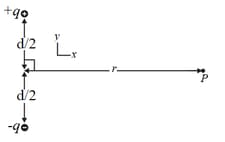
Figure shows a proton on the central axis through a disk with a uniform charge density due to excess electrons. The disk is seen from an edge-on view. Three of those electrons are shown: electron at the disk center and electrons at opposite sides of the disk, at radius from the center. The proton is initially at distance from the disk. At that location. what are the magnitudes of
The electric field due to electron and
The net electric field due to electrons
The proton is then moved to , What then are the magnitudes of
and , at the proton's new location? From and we see that as the proton gets nearer to the disk, the magnitude of increases, as expected. Why does the magnitude of from the two side electrons decrease, as we see from and ?
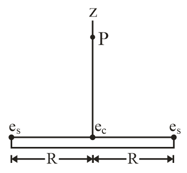
In the given figure an electron is to be released from rest on the central axis of a uniformly charged disk of radius . The surface charge density on the disk is What is the magnitude of the electron's initial acceleration if it is released at a distance , and from the center of the disk? Why does the magnitude of acceleration increase only slightly as the release point is moved closer to the disk?
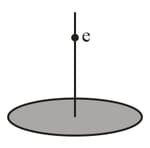
Figure shows three circular arcs centered at the origin of the coordinate system. On each arc, the uniformly distributed charge is given in terms of . The radii are given in terms of What are the magnitude and direction (relative to the positive direction) of the net electric field at the origin due to the arcs?
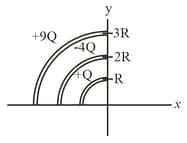
Figure (a) shows a non-conducting rod with a uniformly distributed charge . The rod forms a half-circle with radius and produces an electric field of magnitude at its center of curvature . If the arc is collapsed to a point at a distance from (Fig. b), by what factor is the magnitude of the electric field at multiplied?
